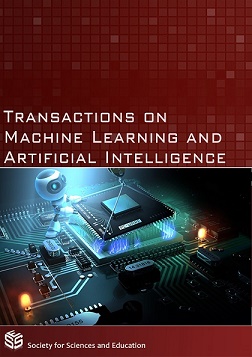Application of Artificial Neural Networks ANN and Adaptive Neuro Fuzzy Inference System ANFIS Models in Water Quality Simulation of Tigris River at Baghdad City
DOI:
https://doi.org/10.14738/tmlai.55.3511Keywords:
Water quality, ANN, LMNN, SCGNN, ANFIS.Abstract
In this paper two different types of artificial neural networks LMNN, SCGNN applied to simulate the total dissolved solids at of Tigris River at El-Wihda station using different water quality parameters data (pH, Temp., Hardness, Turbidity, EC, SO4, CL) at different stations upstream El-Wihda station. Different architecture and different input combinations with trying different numbers of neurons at the hidden layer. In addition, another application, which is an adaptive neuro fuzzy logic inference system ANFIS applied for the same purpose, the results shows that Even though the available data size is relatively small, reasonably a very good results found and a high performance obtained for the water quality prediction. Both ANN and ANFIS models show a very good performance in simulation of the TDS at the required station, and for the two types of ANNs, It can see that LMNN is better than SCGNN.
References
(1) Zhihong, H., Y. and Wang, H., Adaptive neuro fuzzy inference system for classification of water quality status. Journal of Environmental Sciences, 2010. 22(12): p. 1891-1896.
(2) Ozgur, KISI. And Murat, AY., Comparision of ANN and ANFIS techniques in modeling dissolved oxygen. Sixteenth International Water Technology Conference, IWTC-16 2012. Istanbul, Turkey.
(3) Ahour, M., et al., The study of artificial neural network (ANN} efficiency with neuro-fuzzy inference system (ANFIS) in dissolved oxygen simulation of river water. Bull. Env. Pharmacol. Life Sci., 2013. 2(9): p.30-38.
(4) Emamgholizadeh, S. et al., Prediction of water quality parameters of Karoon river (Iran) by artificial intelligence-based models. Int. J. Environ. Sci., 2014. 11: p.645-656.
(5) Thair, S. K., et al., Prediction of water quality of Euphrates river by using artificial neural network model (spatial and temporal study). International Research Journal of natural Sciences, 2014. 2(3): p.25-38.
(6) Chen, W. and Liu, W., Water quality modeling in reservoirs using multivariate linear regression and two neural network models. Advances in Artificial Neural Systems, 2015. Article ID 521721.
(7) McCulloch, W.S., and Pitts, W., A logical calculus of the ideas imminent in nervous activity. Bulletin and Mathematical Biophysics, 1943. 5: p.115–133.
(8) Rumelhart, D.E., et al, Learning internal representations by error propagation. In: Rumelhart, D.E., McClelland, J.L. (Eds.), Parallel Distributed Processing. 1986. MIT Press, Cambridge
(9) Caudill, M., and Butler, C., Understanding Neural Networks. Basic Networks, vol. 1. 1992. MIT Press, Cambridge, MA.
(10) Hagan, M. T. and Menhaj, M. B., Training feed forward network with the Marquardt algorithm. IEEE Trans. on Neural Net., 1994. 5(6): p.989-993.
(11) Battiti, R., First- and second-order methods for learning between steepest descent and Newton’s method. Neural Computation, 1992. 4(2): p. 141-166.
(12) Levenberg, K., A Method for the Solution of Certain Non-linear Problems in Least Squares. Quarterly of Applied Mathematics, 1944. 2(2): p.164–168.
(13) Moller, A., Scaled Conjugate Gradient Algorithm for Fast Supervised Learning.
Neural Networks. Water Resour. Res., 1993. 6(4): p.525-533.
(14) Orozco J, et al, Detecting Pathologies from Infant Cry Applying Scaled Conjugate Gradient Neural Networks. European Symposium on Artificial Neural Networks 23-25 April 2003: p.349-354
(15) Jang, J. S., ANFIS: Adaptive Network Based Fuzzy Inference Systems. IEEE Trans, Syst. Man Cybernet. 1993. 23(3): p.665-685.
(16) Takagi, K.I. and Sugeno, M., Fuzzy identification of systems and its
applications to modeling and control. IEEE Trans. On Systems, Man and Cybern, 1985. 15(1): p.116- 132.
(17) Al-Ansari, N. A., et al, Evaluation of the water quality for the lower reaches of River Tigris using multivariate analysis. J. Water Res., 1986. 5: p.173–187.
(18) Al-Ansari, N. A., et al., Periodicity of selected water quality parameters for the Tigris water at Baghdad. J. Water Res., 1987. 6: p.11–17.
(19) Heydari M., et al., Development of a Neural Network Technique for Prediction of Water Quality Parameters in the Delaware River, Pennsylvania. Middle-East Journal of Scientific Research, 2013. 13(10):
p.1367-1376.
(20) Chokmani, K. et al., Comparison of ice affected streamflow estimates computed using artificial neural networks and multiple regression techniques. Journal of Hydrology, 2008. (349): p.383 – 396.
(21) Teryaki S. et al., Comparison of artificial neural network and multiple linear regression models to predict optimum bonding strength of heat treated woods. International Journal of Adhesion & Adhesives, 2014. (55): p.29–36.
(22) Moriasi, D. N., et ai., Model evaluation guidelines for systematic quantifi cation of accuracy in watershed simulations. Trans. American Society of Agricultural and Biological Engineers ASABE, 2007. 50(3):
p.885-900.
(23) Buyukyildis, M. and Arslan, Cheleng A., Comparison of Monthly Streamflow Forecasting Techniques. 9th word congress Water resources Management in Changing world :Challenges and opportunities, 2015. Istanbul Turkey.
(24) Swingler, K. Applying neural networks - A Practical guide. 1996. Academic Press Ltd., London.






